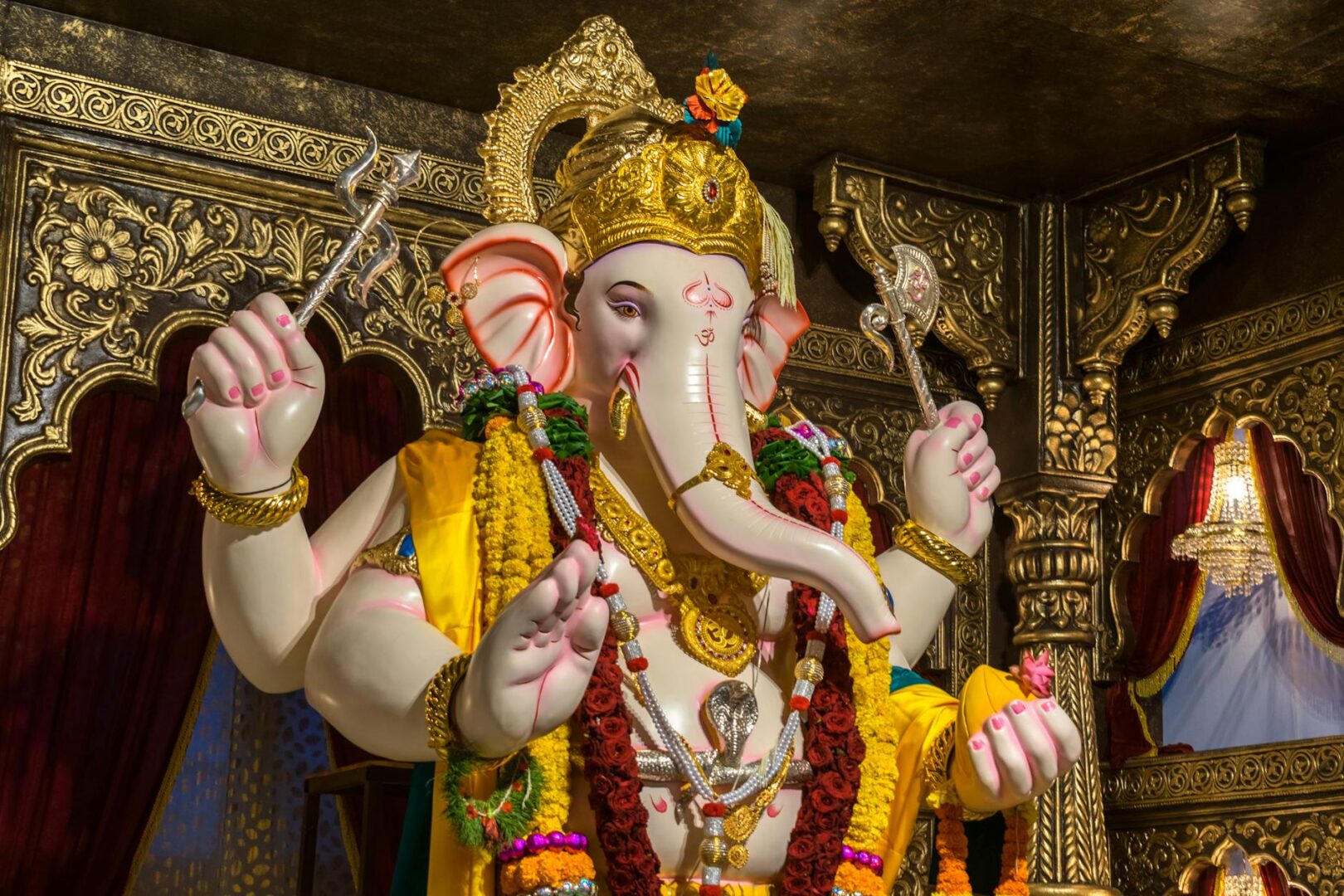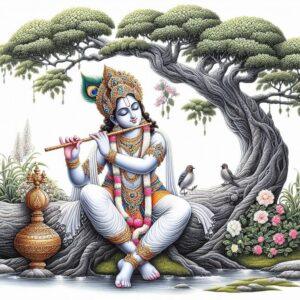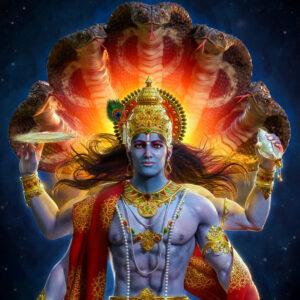
Introduction
Lord Ganesha, one of the most revered deities in Hinduism, holds a special place in the hearts of millions. Recognizable by his elephant head and large belly, he is known as the remover of obstacles, patron of arts and sciences, and the deva of intellect and wisdom. This article aims to provide a comprehensive understanding of Lord Ganesha’s significance, attributes, and influence in both ancient and modern contexts.
Who is Lord Ganesha?
Lord Ganesha is the son of Lord Shiva and Goddess Parvati. He is often depicted with an elephant head, which symbolizes wisdom, and a large belly, representing generosity and total acceptance. His mount is a tiny mouse named Mushika, symbolizing the ability to overcome any obstacle, no matter how small or large. Worshipped before any major undertaking or ceremony, Lord Ganesha is considered the deity who clears the path for success.
Historical Significance of Lord Ganesha
Origins and Birth Story
The story of Lord Ganesha’s birth is both intriguing and symbolic. According to Hindu mythology, Goddess Parvati created him from the sandalwood paste she used for her bath. She breathed life into the figure to guard her while she bathed. When Lord Shiva returned home and found this stranger preventing his entry, a battle ensued, resulting in Ganesha being beheaded. To appease Parvati’s grief, Shiva replaced his head with that of an elephant’s, thus giving birth to the iconic image of Lord Ganesha we know today.
Symbols Associated with Lord Ganesha
The Elephant Head and Its Symbolism
The elephant head of Lord Ganesha is rich with symbolism. Elephants are known for their intelligence, strength, and calm demeanor. These attributes are believed to be embodied by Lord Ganesha. The large ears signify his capacity to listen to the prayers and needs of his devotees, while the small eyes represent focus and concentration.
Attributes of Lord Ganesha
The Four Arms and Their Meaning
Each of Lord Ganesha’s four arms carries a distinct object or makes a specific gesture. Typically, one hand holds an axe (to cut off all bonds of attachment), another holds a rope (to pull you nearer to the highest goal), a third hand carries a modak (a sweet symbolizing the rewards of spiritual pursuit), and the fourth hand is often shown in a blessing pose.
Lord Ganesha’s Family
Parents: Shiva and Parvati
Lord Shiva and Goddess Parvati are two principal deities in Hinduism. Shiva represents destruction and transformation, while Parvati embodies love, fertility, and devotion. Together, they balance each other perfectly, making their family central to many Hindu narratives.
Brother: Kartikeya
Lord Kartikeya, also known as Murugan or Skanda, is the elder brother of Ganesha. He is often depicted as a warrior riding a peacock. While Ganesha is associated with wisdom and removing obstacles, Kartikeya symbolizes courage and victory.
Major Temples Dedicated to Lord Ganesha
Siddhivinayak Temple, Mumbai
One of the most famous temples dedicated to Lord Ganesha is the Siddhivinayak Temple in Mumbai. Built in 1801, this temple attracts thousands of devotees daily who come to seek blessings for success and prosperity.
Dagdusheth Halwai Ganapati Temple, Pune
Another significant temple is the Dagdusheth Halwai Ganapati Temple in Pune. Known for its grand Ganesh Chaturthi celebrations, this temple has a rich history and a massive following.
Famous Festivals Celebrating Lord Ganesha
Ganesh Chaturthi
Ganesh Chaturthi is perhaps the most widely celebrated festival dedicated to Lord Ganesha. It marks his birth and lasts for ten days with grand processions, idol installations, prayers, and finally, immersion of idols in water bodies.
Ganesh Jayanti
Ganesh Jayanti is another festival that celebrates the birth of Lord Ganesha. It is particularly popular in Maharashtra and involves various rituals aimed at invoking the blessings of the deity.
Lord Ganesha in Different Cultures
In Hinduism
Within Hinduism, Lord Ganesha holds a unique position as he is invoked before any other deity during rituals. He transcends sectarian boundaries and is worshipped by followers of Shaivism, Vaishnavism, and Shaktism alike.
Outside Hinduism: Buddhism and Jainism
Interestingly, Lord Ganesha also finds a place in Buddhism and Jainism. In Buddhism, he is considered a protector of Buddha Dharma while in Jainism; he is seen as a guardian deity.
Art and Iconography of Lord Ganesha
Traditional Depictions in Art
Traditional depictions of Lord Ganesha often show him seated with one leg folded under him or dancing gracefully. He is usually adorned with intricate jewelry and bright colors symbolizing joy and prosperity.
Modern Representations
In modern times, artists have taken creative liberties in depicting Lord Ganesha. From minimalist sketches to elaborate sculptures, contemporary representations continue to capture his essence while appealing to new generations.
Lord Ganesha in Literature and Texts
Mention in Vedic Texts
Lord Ganesha makes appearances in various Vedic texts where he is praised for his wisdom and ability to remove obstacles. He is also invoked at the beginning of Vedic chants to ensure success.
Stories from Puranas
The Puranas are replete with stories about Lord Ganesha’s exploits. From his creation by Parvati to his wisdom contest with Kartikeya, these tales highlight his multifaceted personality.
The Importance of Lord Ganesha in Daily Life
Rituals and Prayers
Devotees often begin their day with prayers to Lord Ganesha seeking his blessings for removing obstacles. Common rituals include offering modaks (sweet dumplings), lighting lamps, and chanting mantras.
Mantras and Bhajans
Mantras like “Om Gan Ganapataye Namah” are chanted by devotees to invoke his blessings. Bhajans or devotional songs dedicated to him are also popular during festivals and daily worship.
Philosophical Teachings of Lord Ganesha
Wisdom and Knowledge
Lord Ganesha epitomizes wisdom and knowledge. His elephant head symbolizes intelligence while his large belly signifies an all-encompassing nature that accepts both good and bad experiences as part of life’s journey.
Overcoming Obstacles
One of the primary reasons for worshipping Lord Ganesha is his ability to remove obstacles. Whether they are material or spiritual hurdles, devotees believe that invoking his name can clear their path to success.
Meditation and Yoga with Lord Ganesha
Ganesha Mudra
In yoga practice, the Ganesha Mudra is used to strengthen the heart chakra and increase confidence. This hand gesture involves clasping your hands together in front of your chest while focusing on your breath.
Visualization Techniques
Visualization techniques involving imagining Lord Ganesha can be powerful tools for meditation. Visualizing his image can help devotees feel more connected to his energy, aiding in spiritual growth.
Lord Ganesha’s Influence on Modern Culture
In Films and Music
Lord Ganesha has made numerous appearances in films and music globally. Bollywood often features songs dedicated to him during Ganesh Chaturthi scenes while Western musicians have also incorporated his imagery into their works.
Popularity in Western Countries
The popularity of yoga has also led to an increased interest in Hindu deities like Lord Ganesha in Western countries. Statues of him can be found in yoga studios and homes as symbols of wisdom and prosperity.
Frequently Asked Questions about Lord Ganesha
Why is Lord Ganesha Worshipped First?
Lord Ganesha is worshipped first because he is considered the remover of obstacles. Starting any new venture or ritual with prayers to him ensures that any potential hindrances are cleared away.
What are the Mantras for Lord Ganesha?
One popular mantra for invoking Lord Ganesha’s blessings is “Om Gan Ganapataye Namah.” This mantra helps focus one’s mind on seeking wisdom and removing obstacles.
Why does Lord Ganesha have an Elephant Head?
The elephant head symbolizes wisdom, strength, and understanding—all qualities that are associated with overcoming obstacles and achieving success.
How did Mushika become the Mount of Lord Ganesha?
According to mythology, Mushika was once a celestial musician who was cursed into becoming a mouse. He was later subdued by Lord Ganesha and became his vehicle.
What does Modak symbolize in relation to Lord Ganesha?
Modak symbolizes spiritual knowledge and inner peace. It is believed that offering modaks pleases Lord Ganesha greatly.
Why does Lord Ganesha have a broken tusk?
The broken tusk symbolizes sacrifice. One story explains that he broke it off to write the Mahabharata when Sage Vyasa needed a scribe.
Conclusion
Lord Ganesha remains one of the most beloved deities across various cultures due to his unique attributes, rich history, and profound symbolism. Whether through ancient texts or modern representations, his teachings on wisdom, strength, and overcoming obstacles continue to inspire millions around the world. By understanding his significance more deeply, we can better appreciate the cultural richness he brings into our lives.


